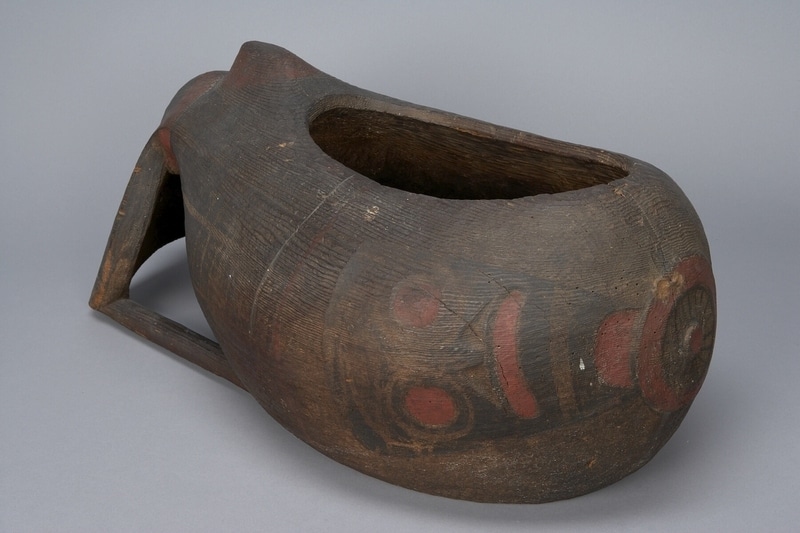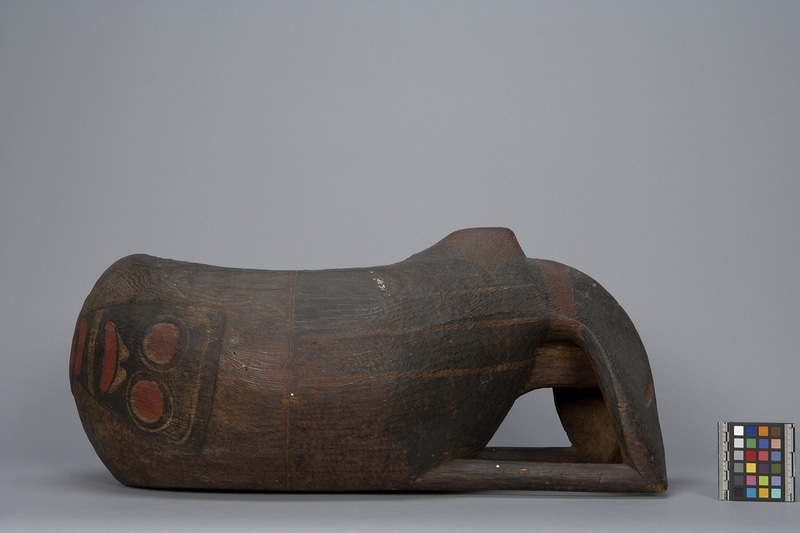Feast Dish Item Number: A1786 from the MOA: University of British Columbia



Description
Carved wooden, oval shaped dish with a triangular shaped end and a central concavity. Made from a single piece of wood, the bowl is shaped like a killer whale’s body with a tail fin carved in shallow relief with two thin red ovoids for detail. Above the tail is a small, rectangular shaped protrusion, possibly representing a dorsal fin. The opposite end has a red circle in circle design with a triangular shaped image radiating from two sides. The painting design is of an eagle. The sides have faded black and red lines.
History Of Use
Large feast dishes were used primarily to hold food served to guests at winter dance ceremonies and potlatches as well as other important social occasions. They also served as symbols of wealth and prestige. The figures represented on feast dishes were family crests and privileges. Important feast bowls were named.
Commemorating the capture of the first whale by the culture hero, Kula.
Cultural Context
ceremonial; potlatch; status; privilege
Iconographic Meaning
Kula was a culture hero who taught the tribe to catch whales. One of two bowls (A1785, A1786) made in the shape of the head and tail of whale, in commemoration of the capture of the first whale by the hero Kula. Whale is represented by a large, rounded head, dorsal fin, blow-hole, and bifurcated tail.
Narrative
Similarity of wood, shallow relief carving and paint suggest that this object is a pair with A1785; the two bowls also seem to be a pair in that they represent both the head and the tale of a whale when put together.
Item History
- Made in British Columbia, Canada during 1800
- Collected in Quatsino, British Columbia, Canada and Xwatis, British Columbia, Canada between 1893 and 1914
- Owned by George H. Raley before November 1948
- Received from H. R. MacMillan (Funding source) and George H. Raley (Seller) during November 1948
What
Who
- Culture
- Kwakwaka'wakw
- Previous Owner
- George H. Raley
- Received from
- H. R. MacMillan (Funding source) and George H. Raley (Seller)
Where
- Holding Institution
- MOA: University of British Columbia
- Made in
- British Columbia, Canada
- Collected in
- Quatsino, British Columbia, Canada and Xwatis, British Columbia, Canada
When
- Creation Date
- during 1800
- Collection Date
- between 1893 and 1914
- Ownership Date
- before November 1948
- Acquisition Date
- during November 1948
Other
- Condition
- fair
- Current Location
- Case 39
- Accession Number
- 1960/0191